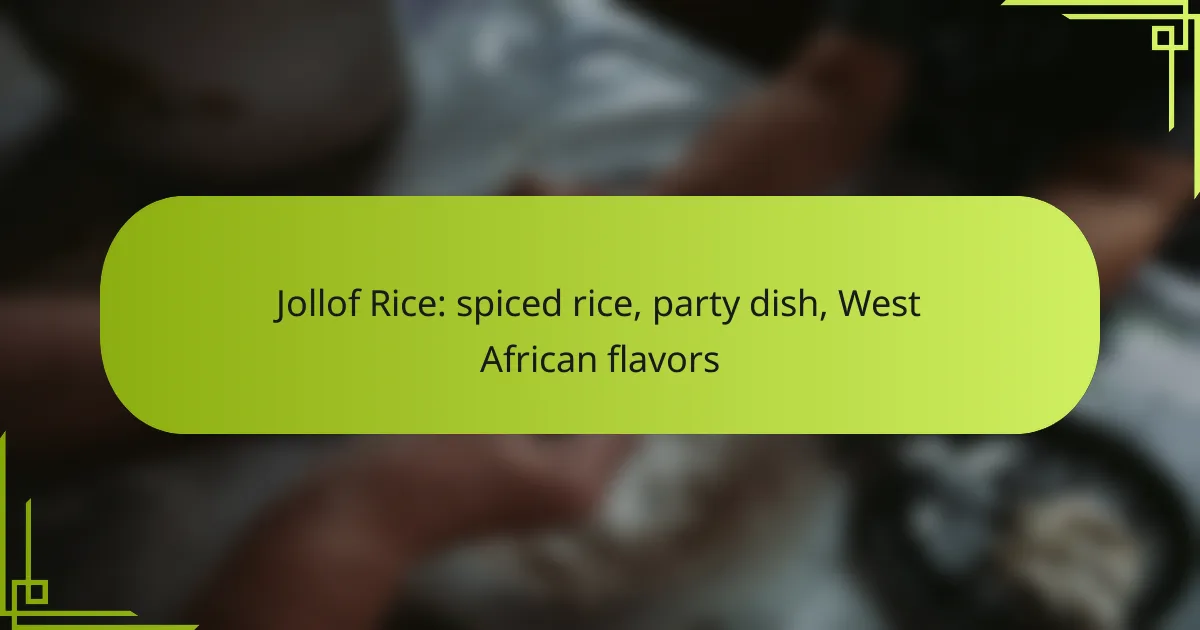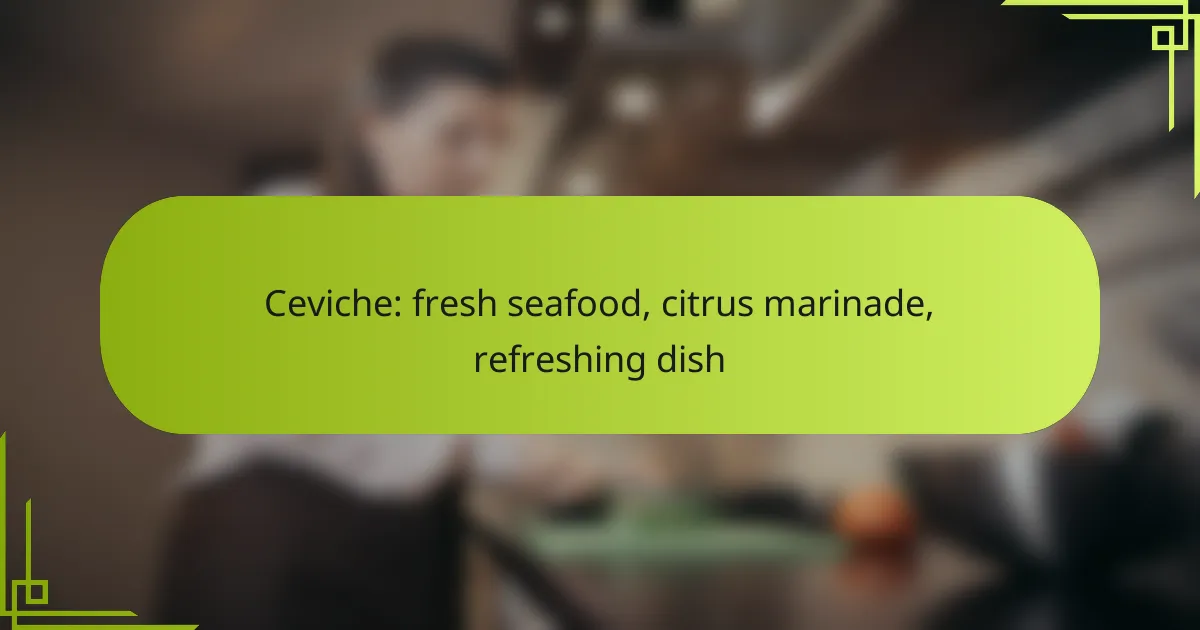Jollof Rice is a beloved West African party dish known for its vibrant flavors and aromatic spices. This versatile recipe typically features rice, tomatoes, and a blend of seasonings, making it a staple at celebrations and gatherings. In Canada, you can easily recreate this dish using local ingredients while still capturing the essence of its authentic taste.

How to make Jollof Rice in Canada?
Making Jollof Rice in Canada involves using local ingredients while capturing the authentic West African flavors. This popular party dish is typically made with rice, tomatoes, and spices, and can be adapted to suit Canadian tastes and ingredient availability.
Ingredients for Canadian Jollof Rice
To prepare Jollof Rice in Canada, gather the following ingredients: long-grain rice, ripe tomatoes, tomato paste, onions, bell peppers, garlic, ginger, and a mix of spices such as thyme, bay leaves, and chili powder. You can also include proteins like chicken or shrimp, and vegetables like peas or carrots for added flavor and nutrition.
When sourcing ingredients, look for fresh produce at local markets or grocery stores. Many Canadian supermarkets carry West African products, making it easier to find authentic spices and sauces.
Step-by-step cooking process
Start by washing the rice thoroughly to remove excess starch, then set it aside. In a large pot, sauté chopped onions, garlic, and ginger until fragrant. Add blended tomatoes and tomato paste, cooking until the mixture thickens and the oil separates.
Next, stir in the spices and any additional vegetables or proteins. Add water or broth, then bring to a boil. Once boiling, add the rice, cover, and reduce the heat to simmer. Cook until the rice absorbs the liquid and is tender, usually around 20-30 minutes. Fluff the rice with a fork before serving.
Common cooking methods
Jollof Rice can be prepared using various methods, including stovetop cooking, oven-baking, or using a rice cooker. The stovetop method is traditional and allows for better control over the cooking process, while oven-baking can create a unique flavor profile with a slightly crispy bottom.
Using a rice cooker is convenient for those who prefer a hands-off approach. Regardless of the method, ensure that the rice is cooked evenly and the flavors are well blended. Adjust cooking times based on the method and the type of rice used for the best results.

What are the best Jollof Rice recipes?
The best Jollof Rice recipes showcase the rich, spiced flavors of West Africa, with variations that reflect regional preferences. Popular recipes include Classic Nigerian, Ghanaian, and Vegetarian Jollof Rice, each offering unique ingredients and cooking methods.
Classic Nigerian Jollof Rice recipe
Nigerian Jollof Rice is known for its vibrant red color and rich flavor, primarily achieved through the use of tomatoes, onions, and a blend of spices. To prepare it, start by blending fresh tomatoes, red bell peppers, and onions, then cook this mixture until it reduces and thickens.
Next, add parboiled rice to the sauce along with chicken or vegetable stock, and let it simmer until the rice is tender. Common additions include bay leaves and thyme for enhanced flavor. Serve it with fried plantains and grilled chicken for a complete meal.
Ghanaian Jollof Rice recipe
Ghanaian Jollof Rice has a distinct taste, often attributed to the use of a different spice blend and the method of cooking. The base sauce typically includes tomatoes, onions, and a variety of spices, but Ghanaians often add curry powder for a unique twist.
To make it, sauté the onions, add the blended tomato mixture, and cook until fragrant. Incorporate the rice and stock, then allow it to cook until the rice absorbs the flavors. Ghanaian Jollof is often served with grilled meats and a side of coleslaw.
Vegetarian Jollof Rice recipe
Vegetarian Jollof Rice is a flavorful alternative that omits meat while still delivering a satisfying meal. Start with the same base of tomatoes, onions, and spices, but enhance it with vegetables like carrots, peas, and bell peppers for added nutrition and texture.
Cook the blended sauce as usual, then add the rice and vegetable broth. Consider adding chickpeas or lentils for protein. This dish pairs well with a fresh salad or avocado slices, making it a hearty option for vegetarians and meat-eaters alike.

Where to find Jollof Rice ingredients in Canada?
Finding Jollof Rice ingredients in Canada can be straightforward if you know where to look. Many local grocery stores and online retailers specialize in West African foods, making it easier to gather everything you need for this popular dish.
Local grocery stores with West African ingredients
In Canada, several local grocery stores cater to West African communities and stock essential ingredients for Jollof Rice. Look for ethnic markets in cities with diverse populations, such as Toronto, Ottawa, and Vancouver. Stores like African Market and Ghanaian Food Store often carry rice, tomatoes, and spices specific to Jollof Rice.
When shopping, check the international aisle of larger supermarkets as well. Some chains may carry popular brands of West African ingredients, including palm oil and seasoning blends. Always inquire with store staff for recommendations on where to find specific items.
Online retailers for Jollof Rice supplies
Online shopping is a convenient option for sourcing Jollof Rice ingredients in Canada. Websites like Amazon and specialty online stores such as Afrofood and Nigerian Food Store offer a wide range of products, including long-grain rice, spices, and sauces. This can save time and provide access to brands that may not be available locally.
When ordering online, consider shipping costs and delivery times, as these can vary significantly. Look for retailers that offer free shipping on orders over a certain amount to maximize your savings. Reading customer reviews can also help ensure you choose high-quality ingredients for your Jollof Rice.

What are the cultural significance and variations of Jollof Rice?
Jollof Rice holds immense cultural significance in West Africa, often serving as a centerpiece for gatherings and celebrations. Its variations reflect regional ingredients and cooking techniques, making it a dish that not only nourishes but also connects communities.
Jollof Rice in West African celebrations
Jollof Rice is a staple at festive occasions such as weddings, birthdays, and holidays across West Africa. It symbolizes unity and hospitality, often shared among family and friends during communal meals.
In many cultures, the preparation of Jollof Rice is a communal activity, with families coming together to cook and enjoy the dish. This shared experience enhances its role as a celebratory food, reinforcing social bonds.
Regional differences in Jollof Rice preparation
Variations in Jollof Rice preparation can be seen across countries like Nigeria, Ghana, and Senegal, each boasting unique flavors and cooking methods. For instance, Nigerian Jollof is known for its spicy and smoky flavor, often achieved by using a grill or open flame.
In contrast, Ghanaian Jollof tends to be sweeter and less spicy, with a focus on fresh tomatoes and a distinct blend of spices. These regional differences highlight the diverse culinary traditions within West Africa, making Jollof Rice a versatile dish that adapts to local tastes.

How to serve Jollof Rice at parties?
To serve Jollof Rice at parties, present it as the centerpiece of your meal, often accompanied by various sides and garnishes. This vibrant dish is best enjoyed in a communal setting, allowing guests to serve themselves and create their own plates.
Best side dishes to pair with Jollof Rice
Popular side dishes that complement Jollof Rice include fried plantains, coleslaw, and grilled chicken or fish. These options provide a balance of flavors and textures, enhancing the overall dining experience.
Consider adding a fresh salad or steamed vegetables for a lighter touch. For a more traditional approach, serve with moi moi, a steamed bean pudding, which adds protein and richness to the meal.
Presentation tips for Jollof Rice
For an appealing presentation, use a large, colorful serving dish to showcase the Jollof Rice. Garnish with sliced tomatoes, onions, or fresh herbs like parsley or cilantro to add visual interest.
Arrange the side dishes around the rice to create a festive look. Using vibrant plates or bowls can enhance the overall aesthetic, making the meal more inviting for guests.

What are the health benefits of Jollof Rice?
Jollof Rice offers several health benefits, primarily due to its ingredients, which often include tomatoes, onions, and various spices. These components provide essential vitamins, antioxidants, and anti-inflammatory properties that can contribute to overall well-being.
Nutritional value of Jollof Rice
The nutritional value of Jollof Rice can vary based on the specific ingredients and preparation methods used. Typically, a serving contains carbohydrates from the rice, vitamins from the vegetables, and healthy fats if oil is included. A standard serving may provide around 200-300 calories, depending on portion size and additional ingredients like meat or fish.
Key nutrients often found in Jollof Rice include vitamin C from tomatoes, fiber from rice, and various B vitamins. The dish can be a good source of energy, making it a popular choice for gatherings and celebrations.
Healthier cooking alternatives
To make Jollof Rice healthier, consider using brown rice instead of white rice for added fiber and nutrients. Reducing the amount of oil used in cooking can also lower the calorie content while still maintaining flavor. Opting for fresh vegetables and lean proteins can enhance the nutritional profile of the dish.
Another alternative is to incorporate more spices and herbs, such as ginger and garlic, which can boost flavor without adding extra calories. Experimenting with vegetable broth instead of water can also enrich the taste while keeping it healthy.










